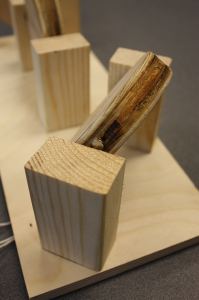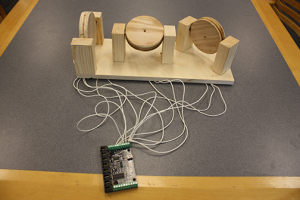Project: Take Shape
Week Eight Newsletter
10-19-2012
Week Eight: Conference Break
Following a successful play test at the Children’s Museum the Take Shape team faced a shortened week due to half of our team leaving in the latter half to attend various conferences around the country. In order to capitalize on our shortened week cycle we met early as a team to go over the notes from our playtesting and see how we can make beneficial improvements to the overall design.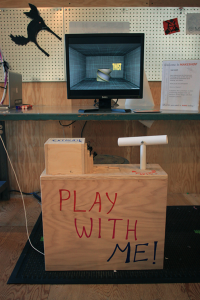
The main aspects we geared our playtest to measure was the ability for multiple modifiers working simultaneously, if children were actually able to operate two modifiers at one time, the 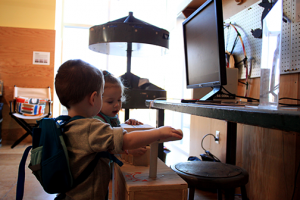 children’s awareness of the connection between the physical modifiers and the digital model on screen and whether or not our design would be able to host multiple children providing input simultaneously making it a successful multiplayer activity. These are all topics we have been hoping would be evident when placing our device in front of the children but the only way to truly know was to gauge their immediate reaction.
children’s awareness of the connection between the physical modifiers and the digital model on screen and whether or not our design would be able to host multiple children providing input simultaneously making it a successful multiplayer activity. These are all topics we have been hoping would be evident when placing our device in front of the children but the only way to truly know was to gauge their immediate reaction.
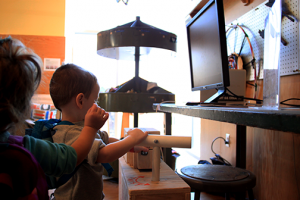 We found out on Saturday that our hopes were totally correct. Despite our playtest build being only one third the size of our final deliverable our team observed multiple children interacting simultaneously. Although our target demographic ranges from five to eight years old we had children as young as twenty-one months successfully operate our physical modifiers. Considering this young age, the connection between the physical and digital content on the screen was lost but we were ecstatic that the simple motion of twisting and extruding was a pleasurable experience. Some of the more concrete feedback came from the museum employees and the parents alike which included a disconnect between the direction of our extrude modifier in the physical sense when compared to the effect on the digital model. In addition we received notes that found some of the kinetic typography distracting to the overall experience. In order to address these issues our console layout and typography have been redone since then to make the feedback as direct and one-to-one as possible.
We found out on Saturday that our hopes were totally correct. Despite our playtest build being only one third the size of our final deliverable our team observed multiple children interacting simultaneously. Although our target demographic ranges from five to eight years old we had children as young as twenty-one months successfully operate our physical modifiers. Considering this young age, the connection between the physical and digital content on the screen was lost but we were ecstatic that the simple motion of twisting and extruding was a pleasurable experience. Some of the more concrete feedback came from the museum employees and the parents alike which included a disconnect between the direction of our extrude modifier in the physical sense when compared to the effect on the digital model. In addition we received notes that found some of the kinetic typography distracting to the overall experience. In order to address these issues our console layout and typography have been redone since then to make the feedback as direct and one-to-one as possible.
In our original schedule the team’s goal was to have four of our seven modifiers built and providing input to the computer by the time our Halves presentation is given. Coming into this
week we had two of the seven prototyped and tested with stretch and mirror left to complete so on Monday morning we made it into the shop. With our overnight order placed from the Phidget website we began to build the physical components that would later house the magnetic and force sensors for input. Throughout the build process we’ve taken precise measurements with thorough documentation for when the time comes to have all of our modifiers CNC routed in a woodshop on the main Carnegie Mellon campus with the help of Ben Carter.
Completing the mirror modifier which allows for reflection in the X-, Y-, and Z-axis was a big step as it is more involved than it would be to
turn out a prototype of stretch. Using a series of six magnetic sensors, two for each axis, we are able to track whether the object is, or is not, mirrored. The reasoning behind the magnetic force sensor versus a rotary encoder-type device is we only need to know two positions along the point of rotation for each mirror so by using magnets we achieve this result quite simply.
In the end Kevin and I were able to complete the pair of modifiers to bring our total up to the scheduled four we were hoping to have. This allowed us to hand them off to the programmers 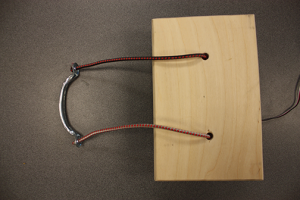
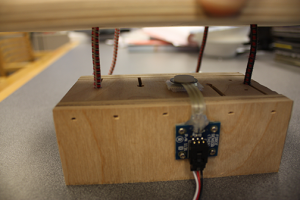 prior to leaving for our conference and let them integrate into the system we have established. All of this is to be shown at our Halves presentation the following Friday, October 26th. This presentation will be given in front of faculty, staff and students of the E.T.C. as well as our clients/contact personnel from the MAKESHOP.
prior to leaving for our conference and let them integrate into the system we have established. All of this is to be shown at our Halves presentation the following Friday, October 26th. This presentation will be given in front of faculty, staff and students of the E.T.C. as well as our clients/contact personnel from the MAKESHOP.
In the meantime we will be awaiting the arrival of our 80/20 aluminum framing that will serve as the skeleton of our machine. To make the most of our demo on Friday we will be assembling these pieces, adding the main console piece and installing the four modifiers we currently have built. This is the halfway point and we are right on schedule. In the next few weeks we will have some major improvements and updates so please check back for more information.
